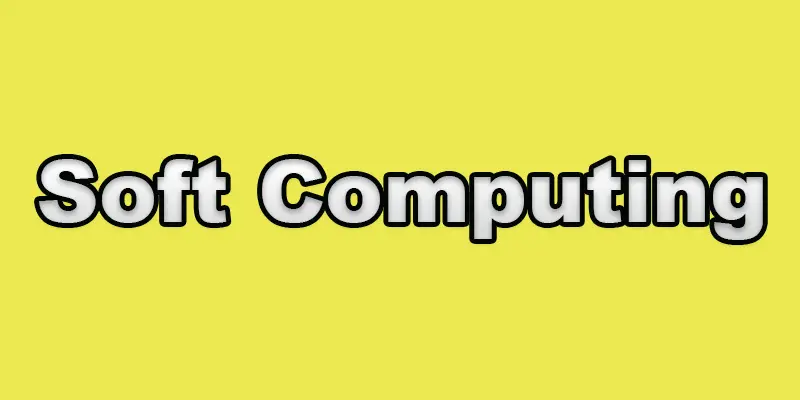Soft Computing | Definition, Example, Application, History, Element, More
Published: 13 Jan 2025
What is Soft Computing?
In computer science, soft computing is a versatile technique used to tackle challenging real-world issues that are challenging to handle with more conventional, accurate approaches. It handles uncertainty, imperfect data, and approximations by combining several techniques like fuzzy logic, neural networks, and evolutionary algorithms. This approach is especially useful in areas like machine learning, image recognition, and natural language processing, where outcomes aren’t always exact but need intelligent solutions. Soft computing makes systems more adaptable and capable of learning, much like how humans solve problems in everyday life.
Definition of Soft Computing
Soft computing is a type of computing that uses flexible methods to solve complex problems when exact answers aren’t possible. Instead of strict rules, it relies on techniques like fuzzy logic, neural networks, and genetic algorithms to handle uncertainty and make smart guesses. This approach is helpful in areas like artificial intelligence, where solutions need to be adaptable and close to real-world thinking.
Example of Soft Computing
Here are some common examples of soft computing:
- Spam email detection: Uses fuzzy logic to identify spam.
- Voice recognition: Neural networks help recognize spoken words.
- Image filtering: AI refines image quality automatically.
- Weather forecasting: Handles uncertain data for predictions.
- Medical diagnosis: Assists in diagnosing with fuzzy information.
- Robotics: Enables robots to adapt to changing environments.
Soft computing makes these processes flexible and closer to human-like problem-solving.
History of Soft Computing
The history of soft computing began in the 1960s when scientists started exploring new ways to make computers handle uncertain or vague data, much like humans do. Traditional computing, which relied on exact rules and rigid logic, wasn’t always effective for complex real-world problems. In the 1960s and 1970s, techniques like fuzzy logic (introduced by Lotfi Zadeh) and neural networks began to emerge. These methods allowed computers to process “fuzzy” information and learn from data patterns.
In the 1980s and 1990s, genetic algorithms and other adaptive techniques were added to the mix, creating what we now call soft computing. By combining these approaches, soft computing became widely used in fields like artificial intelligence, robotics, and data analysis, paving the way for the smart technology solutions we see today.

Soft Computing Applications
Here are five applications of soft computing :
- Medical Diagnosis: Soft computing helps doctors analyze symptoms and uncertain data to make accurate diagnoses, especially when the information is incomplete.
- Weather Prediction: It processes vast amounts of changing data to predict weather conditions, even when patterns are hard to pinpoint exactly.
- Voice Recognition: Soft computing enables devices like smartphones to recognize voices and understand spoken commands, adapting to different accents and tones.
- Robotics: Robots use soft computing to navigate new environments, handle obstacles, and make quick decisions, just like humans.
- Spam Filtering: It helps email systems identify and filter out spam messages by learning patterns from previous spam emails, even if they aren’t identical.
These applications make technology more adaptable and closer to human-like decision-making.
Characteristics of Soft Computing
- Handling Uncertainty: Soft computing can work with incomplete, vague, or uncertain data, making it ideal for real-world problems where information isn’t always clear or precise.
- Learning and Adaptation: It uses methods like neural networks that allow systems to learn from data patterns and improve over time, similar to how humans learn from experience.
- Flexibility in Problem-Solving: Unlike strict traditional computing, soft computing combines techniques like fuzzy logic and genetic algorithms, allowing it to find approximate solutions instead of exact answers, which is helpful in complex situations.
Need of Soft Computing
Soft computing is needed for several reasons:
- Complexity of Real-World Problems: Many problems we face in everyday life are too complicated for traditional computing methods, which rely on exact rules. Soft computing helps tackle these complexities.
- Handling Uncertainty: In many situations, data can be incomplete or uncertain. Soft computing techniques can make sense of this fuzzy information, leading to better decisions.
- Adaptability: As technology evolves, systems must adapt to new information and environments. Soft computing allows systems to learn and adjust, making them more effective.
- Improved Efficiency: Soft computing methods often find approximate solutions faster than traditional methods, which can save time and resources in problem-solving.
- Realistic Modeling: It helps create models that closely resemble human thinking and decision-making, making machines smarter and more intuitive in their interactions.
Overall, soft computing enhances the ability to solve complex problems in various fields, from healthcare to finance.
Element of Soft Computing
The key elements of soft computing include fuzzy logic, neural networks, genetic algorithms, evolutionary computation, and probabilistic reasoning. Fuzzy logic helps systems understand vague information, while neural networks learn from data patterns, mimicking the human brain. Genetic algorithms evolve solutions over time, finding the best answers to complex problems. Together, these elements allow soft computing to effectively handle uncertainty and adapt to real-world challenges.
Here are Important Elements of Soft Computing are as Follows:
Fuzzy Logic
Fuzzy logic is a method that helps computers deal with uncertain or vague information. Instead of giving only true or false answers, it allows for degrees of truth, like “partially true” or “mostly false.” This makes it useful for real-world situations where things aren’t always clear-cut, such as in decision-making or control systems. By using fuzzy logic, machines can make smarter and more flexible choices.
Neural Networks
Neural networks are computer systems designed to mimic how the human brain works. They consist of interconnected nodes, or “neurons,” that process information in layers. By learning from data patterns through training, neural networks can recognize complex relationships and make predictions, making them useful for tasks like image recognition and speech processing. This ability to learn and adapt helps them improve their performance over time.
Genetic Algorithms
Genetic algorithms are problem-solving methods inspired by the process of natural selection. They work by creating a population of possible solutions and then evolving them over time. The best solutions are selected, combined, and slightly altered to create new generations of solutions. This approach helps find optimal or near-optimal answers to complex problems, such as scheduling or resource management, by exploring many possibilities efficiently.
Evolutionary Computation
Evolutionary computation is a set of techniques that simulate the process of natural evolution to solve problems. It uses mechanisms like selection, mutation, and crossover to evolve solutions over time. By mimicking how nature selects the fittest individuals, these methods explore different possibilities and improve results. This approach is effective for finding optimal solutions in complex scenarios, such as optimization and machine learning tasks.
Probabilistic Reasoning
Probabilistic reasoning is a method that helps systems make decisions based on uncertainty and incomplete information. It uses probabilities to evaluate different outcomes and predict the likelihood of events happening. This approach allows computers to assess risks and make informed choices even when all the details aren’t available. Probabilistic reasoning is useful in fields like medical diagnosis, finance, and artificial intelligence, where uncertainty is common.
Together, these elements enable soft computing to tackle complex problems more effectively and adaptively.

Soft Computing vs Hard Computing
| Soft Computing | Hard Computing |
|---|---|
| Approximate solutions | Exact solutions |
| Deals well with uncertainty | Struggles with uncertainty |
| Highly flexible and adaptable | Rigid and fixed |
| Can learn from data | No learning; follows strict rules |
| Handles complex, real-world problems | Suitable for simpler, well-defined problems |
| Fuzzy logic, neural networks | Traditional algorithms, precise calculations |
Conclusion about Application Soft Computing
Soft computing is an essential approach that enables computers to tackle complex problems in a flexible and adaptable way. Soft computing can handle uncertainty and make smarter decisions by using techniques like fuzzy logic, neural networks, and genetic algorithms. Its ability to learn from data and find approximate solutions makes it valuable in various fields, such as artificial intelligence, medicine, and engineering. Overall, soft computing enhances the effectiveness of technology, allowing it to better mimic human-like thinking and problem-solving.
FAQS – Soft Computing
The main components of soft computing are fuzzy logic, which deals with uncertainty; neural networks, which learn from data; genetic algorithms, which find solutions through evolution; and probabilistic reasoning, which uses probabilities to make decisions. Together, these components help solve complex problems effectively.
Genetic algorithms work by mimicking the process of natural selection. They start with a group of possible solutions and evaluate their effectiveness. The best solutions are combined and slightly changed to create new ones. This process is repeated over several generations, gradually improving the solutions to find the best answer to a problem.
A soft computing course teaches students about flexible computing methods that solve complex problems. It covers techniques like fuzzy logic, neural networks, and genetic algorithms. Students learn how these methods can handle uncertainty and make decisions similar to human thinking.
A soft computing journal includes articles and research on various topics related to soft computing. These can include new methods, applications of fuzzy logic, neural networks, genetic algorithms, and case studies. The journal helps researchers share their findings and advancements in the field.

- Be Respectful
- Stay Relevant
- Stay Positive
- True Feedback
- Encourage Discussion
- Avoid Spamming
- No Fake News
- Don't Copy-Paste
- No Personal Attacks

- Be Respectful
- Stay Relevant
- Stay Positive
- True Feedback
- Encourage Discussion
- Avoid Spamming
- No Fake News
- Don't Copy-Paste
- No Personal Attacks





